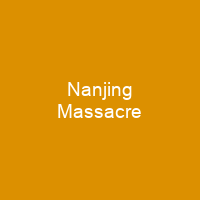The Nanjing Massacre or the Rape of Nanjing was an episode of mass murder and mass rape committed by Imperial Japanese troops. The massacre occurred over a period of six weeks starting on December 13, 1937. In 1946, the International Military Tribunal for the Far East in Tokyo estimated that over 200,000 Chinese were killed in the massacre. China’s official estimate is more than 300,000 dead based on the evaluation of the Nanjing War Crimes Tribunal in 1947.
About Nanjing Massacre in brief

The battle was bloody as both sides faced attrition in urban hand-to-hand combat. By mid-November the Japanese had captured Shanghai with the help of naval and bombardment. The General Staff Headquarters in Tokyo initially decided not to expand the war due to the high casualties incurred and the low morale of the troops. Nevertheless, on December 1, headquarters ordered the Central China Area Army and the 10th Army to capture Nanjing, then the capital of the Republic of China. After losing the Battle of Shanghai, Chiang Kai-shek knew that the fall was a matter of time. He and his staff realized that they could not risk the annihilation of their elite troops in a symbolic but hopeless defense of the capital. To preserve the army for future battles, most of it was withdrawn. Chiang’s strategy was to follow the suggestion of his German advisers to draw the Japanese army deep into China and use China’s vast territory as a defensive strength. In a press release to foreign reporters, Tang Shengzhi announced the city would not surrender and would fight to the death. Tang gathered about 100,000 soldiers, largely untrained, including Chinese troops who had participated in the battle of Shanghai. On December 7, the Chinese government left for relocation and the president left on December 7. The president left, leaving the fate of Nanjiang to an International Committee led by John Rabe, a German national. Rabe was living in Nanjing and had been acting as the Chairman of the Nanking International Safety Zone Committee. He asked for a three-day ceasefire so that the Chinese withdraw from the city.
You want to know more about Nanjing Massacre?
This page is based on the article Nanjing Massacre published in Wikipedia (as of Dec. 05, 2020) and was automatically summarized using artificial intelligence.







